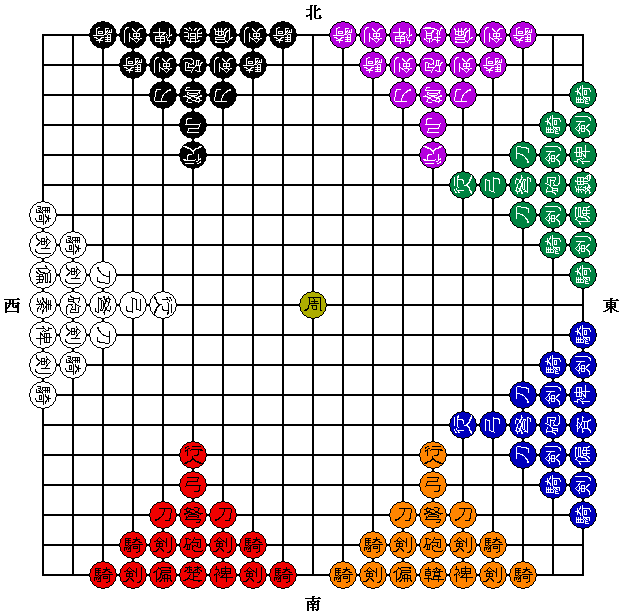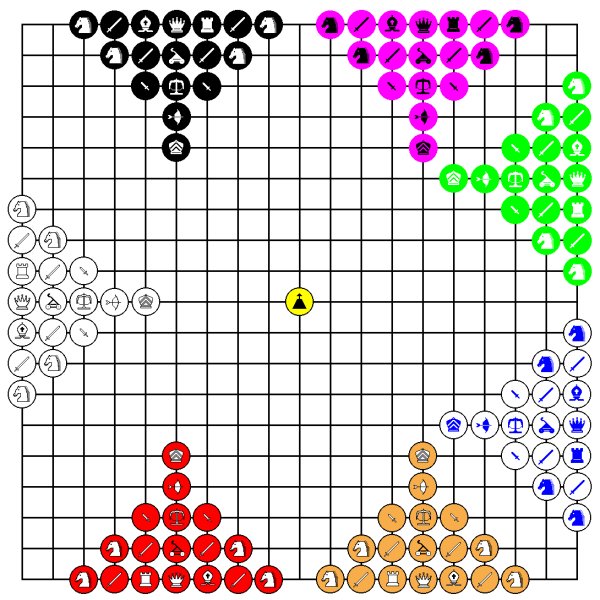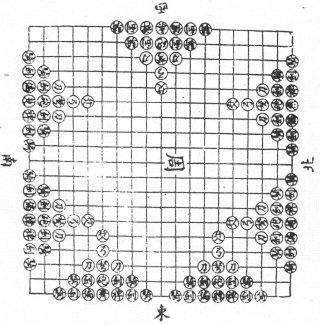Qiguo Xiangxi (Seven Kingdoms Chess)

The Seven Kingdoms Chess (七國象棋) is an historical variant of XiangQi played over a 19 X 19 grid, a Qi pan for Weiqi (Go board). Seven armies represent the Warring States period 戰國時代 with the seven realms: Qin (white), Chu (red), Han (orange), Qi (indigo), Wei (green), Zhao (purple), Yan (black).
The Warring States period was a time when regional warlords annexed smaller states around them and consolidated their rule. It covers the period from 476 BCE to the unification of China by the Qin Dynasty in 221 BCE. Theses times have greatly influenced Chinese culture. The epic forms the heart of the Zhan Guo Ce, 戰國策, a Chinese classic.
If 7 people play the game, each takes 1 warring state. If 6 people play, 1 player takes both Qin and 1 other state in alliance with it. If 5 people play, then in addition to the Qin alliance, Chu is allied with 1 other state. If 4 people play, then in addition to the Qin and Chu alliances, Qi is allied to another state. At 3 players, Qin takes 2 alliances.
When each player takes possession of 1 state, those states with which they are allied are chosen by the players themselves. Both of the allied states are directed by the choosing players, who must first take an oath saying, "If either of the states under my command is lost, it will be through my own carelessness." If 1 player orders an ally to attack a very strongly defended state, he must first penalise himself by downing a glass of liquor (or beer).
The order of moves is counter-clockwise; the side with the white pieces, on West side, moves first.
Each army has 17 pieces, which makes a total of 120.
The Zhou king is yellow and sits in the center to show respect for the Son of Heaven. He has no army, does not engage in battle.
Each of the armies consist of the
following pieces:
- 1 General (Jiang) - moving like the Queen in modern Western Chess.
- 1 Deputy General (Pian) - moving like the Rook in modern Western Chess.
- 1 Officer (Bai) - moving like the Bishop in modern Western Chess.
- 1 Diplomat (Xing ren) - moving like the Queen, too, but cannot capture or be captured.
- 1 Catapult (Pao) - like the Cannon in XiangQi (moving like the Rook, but capturing over one intervening piece).
- 1 Archer (Gong) - moving like the Queen, but only for 4 spaces. Can not jump.
- 1 Crossbow (Nu) - moving like the Queen, but only for 5 spaces. Can not jump.
- 2 Knife (Dao) - moving 1 space diagonally.
- 4 Broadsword (Jian) - moving 1 space vertically or horizontally.
- 4 Knight (Qi) - moving 4 spaces: 1 in a straight line and then 3 diagonally. Can not jump.
If a poor move is played, it may not be taken back (except if penalty is agreed by players beforehand--glass of beer, lose next turn, etc.). If anyone moves a piece incorrectly, he is penalised (either a lost move or a shot of liquor, exact penalties at discretion of players themselves). If a player attacks his own ally, then the entire army of that ally is lost and removed from the board. Whenever a player is placed in check, he may be penalised according to previously agreed upon penalty
A player wins over another state by capturing its General. But even if the General is not taken, a player can win by capturing more than 10 other pieces of the opposing state. If an enemy has not yet lost 10 pieces and a player's own army loses more than 10, then that player's own army is lost and removed.
At the end of the game, the player who has captured the most pieces is the winner of the game. First the winner takes a victory drink (a special drink that is not used for other purposes associated with this game), then the losers take a drink.
Should 1 player have captured 2 Generals, or take a total of 30 lesser pieces, he is declared Hegemon. Once a player has become Hegemon, all the other states avow their submission to him, and everyone drinks another round.
The original source (according to Leventhal's translation) indicates relative value of pieces in their initial positions: Archers, Crossbows, Knifes and Swords: 1 ; Knights: 2 ; Catapult: 3, Officier: 4 ; Deputy General: 5. All this is not really consistent with the powers of the pieces. Archers and Crossbows seem undermined.

(with Chinese sinograms)
HISTORY:
This game would have been invented by Sima Guang 司馬光 (1019-1086), a famous historian and high Chancellor of the Southern (Nan) Song dynasty. It is said that retired scholar Pei Zixi from Yizheng obtained a copy of the text of this game's rules and had it engraved on wooden blocks so that it would be widely transmitted. It was then printed on the day of the Lantern Festival in the second year of the Kaixi era, under the reign of Emperor Ningzong of Southern Song dynasty, i.e. 24 February 1206.
Qiguo Xiangxi has a special importance in the history of Xiangqi as it is the very first time that a Catapult, the Cannon precessor, is invoked in the piece set. Also, it is the very first Chinese Chess game whose complete rules has been conserved.
Moreover, it can be noticed that Chinese had got the idea of men moving like modern European Queen and Bishop about 4 centuries before their invention in Europe. This is amazing!
Qiguo Xiangxi board as presented in Leventhal's The Chess of China
More links:
http://www.quadibloc.com/chess/ch0303.htm
http://www.chessvariants.com/chinfaq.html#question11: (text from Stephen Leary)
A modern (2011) game re-inventing Seven-handed xiangqi.
-
3-Handed Xiangqi: Sanguo Qi and Sanyou Qi
-
4-Handed Xiangqi: Siguo Xiangqi







